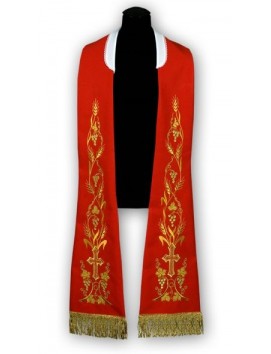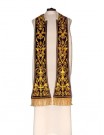No products
Roman stole
A Roman stole is a type of vestment worn by clergy members in various Christian denominations, including Roman Catholic, Anglican, Lutheran, Methodist, Presbyterian, United Church of Christ, Christian Church (Disciples of Christ), and other denominations. The Roman stole is a long colored band of cloth worn around the neck with two ends hanging parallel in the front. It is often decorated with unique orphreys and motifs, such as machine embroidery or gold cord. The Roman stole is available in various colors, including red and white. It is made of high-quality fabric, such as velvet, silk, or lampas, and is often embroidered with fine yarns. The Roman stole is an important liturgical vestment that symbolizes the authority and responsibility of the clergy member who wears it.
A Roman stole is a type of vestment worn by clergy members in various Christian denominations, including Roman Catholic, Anglican, Lutheran, Methodist, Presbyterian, United Church of Christ, Christian Church (Disciples of Christ), and other denominations. The Roman stole is a long colored band of cloth worn around the neck with two ends hanging parallel in the front. It is often decorated with unique orphreys and motifs, such as machine embroidery or gold cord. The Roman stole is available in various colors, including red and white. It is made of high-quality fabric, such as velvet, silk, or lampas, and is often embroidered with fine yarns. The Roman stole is an important liturgical vestment that symbolizes the authority and responsibility of the clergy member who wears it.
The Roman Stole: A Symbol of Authority and Faith
The Roman stole is a significant vestment in the Christian clergy, symbolizing the authority and commitment of those ordained to serve. Its history and evolution are as rich and intricate as the embroidered patterns that often adorn it.
Origins and Historical Development
The Roman stole has its roots in ancient Rome, where it was a symbol of authority and power among government officials. With the rise of the Christian church, the stole was adopted as a vestment for bishops and priests, signifying their ordination and authority to lead worship services.
The earliest evidence of the stole's use in Rome dates back to the second half of the eighth century, with its manner of use remaining essentially the same to this day. Initially, it may have been a cloth folded into a band, evolving into a simple band over time. The stole was often ornamented with fringe, tassels, or little bells, and by the sixteenth century, it became customary to place a cross in the center and at the ends.
Symbolism and Use
The Roman stole is a long, narrow band of fabric, typically made of precious materials like silk or velvet, and is often embroidered with religious symbols. It is worn around the neck and draped over the shoulders, with variations in how it is worn signifying different ranks within the clergy.
In the Roman Catholic tradition, the stole is a symbol of immortality and is considered the unique badge of the ordained ministry, conferred at ordination. It serves as a visible sign of the priest's authority and a reminder of their service to the community.
Liturgical Significance and Colors
The stole's color can vary depending on the liturgical season or feast day, with each color holding its own significance. For instance, white symbolizes joy and purity, red is linked to the Holy Ghost and martyrdom, green represents hope, purple denotes repentance, and black signifies mourning.
Modern Adaptations and Care
Today, Roman stoles are available in various styles and colors to suit different occasions and denominational requirements. They are made from high-quality fabrics and may include customization options such as embroidery or unique embellishments.
Proper care is essential to maintain the stole's appearance, often involving gentle handwashing or dry cleaning, depending on the fabric type.
FAQs
Who can wear a Roman stole?
The Roman stole is worn by members of the clergy, including priests, deacons, bishops, and other ordained ministers in Christian churches.
What does the Roman stole symbolize?
It symbolizes the authority and commitment of the clergy member to their faith, as well as their service to the community.
How should a Roman stole be worn?
A priest or bishop wears the stole around the neck with the ends hanging down, while a deacon wears it over the left shoulder with ends joined under the right arm.
Can the Roman stole be customized?
Yes, many designers offer customization options for Roman stoles, allowing for personalization with initials, specific embroidery, or unique embellishments.
In conclusion, the Roman stole is not just a piece of fabric; it is a storied garment that carries the weight of history, tradition, and spiritual significance. It remains an essential part of religious wear, symbolizing the solemn duties and the unwavering faith of those who wear it within the Christian church.

























